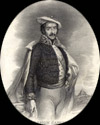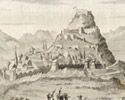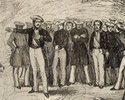19th Century´s militar history in the Basque Country
RAMON CABRERA. (1806-1877)
 Cabrera was born in Tortosa on the 27th of December, 1806. After studying theology with the Trinitarian monks, he left the Seminar to enlist as a Carlist volunteer with Colonel Barón de Herbés in Morella for the First Carlist War. When the Colonel was defeated and executed in 1833, Cabrera's military skills soon became apparent. In April 1835, Carlos V appointed him leader of the Carlist forces of Aragón and Valencia to replace Manuel Carnicer. This gave the war a much-needed boost, not least because of Cabrera's extraordinary mobility. He became the Zumalacárregui of the region and was nicknamed the "Tiger of the Maestrazgo" because of his cruelty.
Cabrera was born in Tortosa on the 27th of December, 1806. After studying theology with the Trinitarian monks, he left the Seminar to enlist as a Carlist volunteer with Colonel Barón de Herbés in Morella for the First Carlist War. When the Colonel was defeated and executed in 1833, Cabrera's military skills soon became apparent. In April 1835, Carlos V appointed him leader of the Carlist forces of Aragón and Valencia to replace Manuel Carnicer. This gave the war a much-needed boost, not least because of Cabrera's extraordinary mobility. He became the Zumalacárregui of the region and was nicknamed the "Tiger of the Maestrazgo" because of his cruelty.
In retaliation for the deaths of two Cristine mayors in the Alcañiz district, General Nogueras shot Cabrera's mother, Ana María Griñó, on the 16th of February 1836 in Tortosa. The news was echoed across Europe and took the war in the Maestrazgo to a new, even tougher level.
In autumn 1836, he accompanied Gómez on his expedition across La Mancha, Andalusia and Extremadura and the following year, he joined the northern troops on the Royal Expedition.
 Following his victory in Maella in October 1838, he was appointed lieutenant general and Count of Morella. Cabrera even managed to set up a small state with its capital at Morella, the hub of Carlist activity.
Following his victory in Maella in October 1838, he was appointed lieutenant general and Count of Morella. Cabrera even managed to set up a small state with its capital at Morella, the hub of Carlist activity.
He refused to accept the Bergara Convention of 1839 and retired to northern Catalonia with his army. After a final show of resistance in Berga, he crossed the French border in July 1840, thus ending the First Carlist War.
 Six years later, at the outbreak of the Matiners' War, he was appointed commander-in-chief of the Carlist forces in Aragón, Catalonia, Valencia and Murcia by Carlos VI. In 1848, he entered Catalonia to lead the Carlist troops and organised an army of close to 9,000 men. In January 1849, he was awarded the title of Marquis of the Ter for his actions in the Battles of Amer and El Pasteral, where he was injured. Three months later, however, he was forced to return to France because the war did not take off outside Catalonia and the government forces were overwhelmingly superior.
Six years later, at the outbreak of the Matiners' War, he was appointed commander-in-chief of the Carlist forces in Aragón, Catalonia, Valencia and Murcia by Carlos VI. In 1848, he entered Catalonia to lead the Carlist troops and organised an army of close to 9,000 men. In January 1849, he was awarded the title of Marquis of the Ter for his actions in the Battles of Amer and El Pasteral, where he was injured. Three months later, however, he was forced to return to France because the war did not take off outside Catalonia and the government forces were overwhelmingly superior.
In 1850, he married Marian Katherine Richards, an English Lady of Anglican faith from high society, who possessed a great fortune. Over time, he began to distance himself from centres of Carlist exiles and sympathise with Moderate and more liberal ideology.
Carlos VII offered him the post of commander-in-chief during the third Carlist uprising, but Cabrera rejected the offer, refusing to take part in another civil war. In 1875, he recognised Alfonso XII as the legitimate monarch and on the 21st of August of that year, he was appointed Capitán General (governor general) and all of his titles and honours obtained on the battlefield were acknowledged.
Ramón Cabrera died in England on the 24th of May, 1877.

